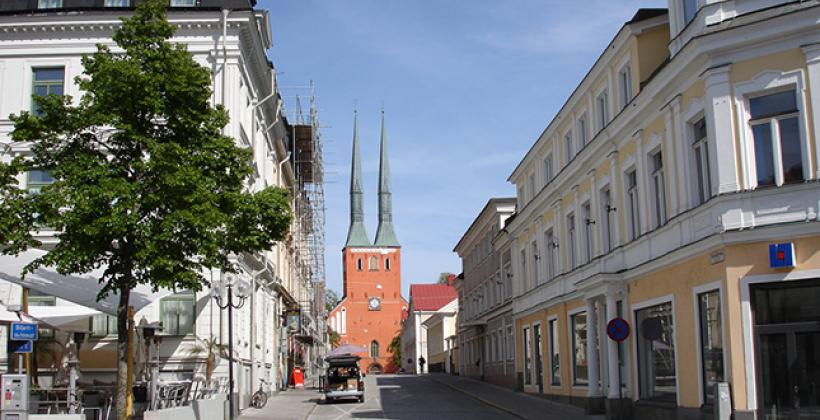
Location
Description
Växjö municipality, together with its inhabitants, businesses, organisations and university, are all working towards a better environment and a smaller carbon footprint. The city has high ambitions to make itself sustainable, energy-efficient, fossil fuel-free and with a large proportion of wooden buildings. Växjö aims to be at the forefront and therefore participates in various EU projects, among which is the READY project, that demonstrates how the demand of energy and particularly the needs for fossil fuels and release of CO2 can be considerably reduced to nearly zero, and show a sustainable way forward for other European cities.
The project has a whole-city approach, which includes interventions in the fields of retrofitting buildings, integrated energy systems, ICT, and mobility and transportation.
Demo Site Expected Impact
The demo site of Växjö accounts for a total primary energy reduction of 8 020 MWh with total savings of CO2 emissions amounting to 1 778 tonnes.
Technologies
Buildings and energy
The implemented measures in the demo site of Växjö within the READY project are:
Energy efficiency in buildings
- Retrofitting the building envelope
- Refurbishment of 376 apartments in the Araby housing district (the sub-areas of Alabastern and Bärnstenen) as well as the City Hall building located in central Växjö, which covers 11 162 m2
- Small energy storage
- Some renovated buildings are to be tested as a pilot, being equipped with smart district heating sub-centrals in order to use the building as accumulator.
Energy systems integration
- District heating and cooling
- The READY project further develops and enhances the existing district heating and cooling systems in order to increase the overall energy efficiency in the city. Two existing district cooling networks are to be connected so as to increase the renewable energy sources production and increase the amount of waste heat used in the system. The integration of the DH network and the district cooling network is to be performed with absorption cooling machines, making it possible to produce cooling with heat when the electricity price is high and produce cooling with electricity when the prices are low.
- Waste heat recovery
- Connection of waste heat sources from more local industries. The waste heat is either to be recovered in the heating system and used as an energy source or used to produce electricity. In both cases, local cooling machines will not cool the waste and therefore the electricity consumption at the local industries will decrease as well.
- The Green Operating Center in Växjö is progressing, where an innovative cooling system with an integrated piping system is connected to the computer centre to cool down the server hall with district cooling return water.
- This centre is also designed with efficient hot and cold aisles, making it possible to utilise the heat from servers that would otherwise have been wasted. In this way the PUE (power usage effectiveness) value goes down from 2.2 to 1.2.
Mobility & Transport
- Clean fuels and fuelling infrastructure
- A number of pilot charging stations will be realised in cooperation with the electric utility service provider EON
- Electric, hybrid and clean vehicles
- Carpooling
ICT
- Neighbourhood energy management system
- The retrofit of the sub-areas Alabastern and Bärnstenen will include a number of innovative utility services – all of them connected to the advanced ICT management system, with the purpose of optimising the overall performance and reducing energy consumption.
- Smart electricity grid
- Control of the supply and demand and optimisation of the use/re-use of energy across the integrated energy systems (electricity and electric vehicles, as well as district heating)
- Urban data platform
- Växjö uses a common and open ICT platform enabling all the required types of services and communication. The communication platform will benefit from the existing open broadband network (provided by Wexnet) inside each building, which is supplemented with support for a digital low-power sensor network provided via a smart communication node installed in each apartment. The smart node is planned to communicate with measuring devices, individual appliances and other sources of information. The software platform is to integrate the utility services and enable real-time visualisation of services on various platforms such as web, tablet, smart phone and television.
Building aspects
- Building Energy Services
- heating and cooling
- Building Energy Services
- heating and DHW
- Building Energy Services
- lighting and appliances
- Building Energy Services
- other please specify
- Installed Renewable Energy Sources
- hybrid collectors
- Technology used to supply the buildings
- district cooling (DC) network
- Technology used to supply the buildings
- district heating (DH) network
- Technology used to supply the buildings
- electrical equipment
- Technology used to supply the buildings
- heat pump: compression
- Technology used to supply the buildings
- other please specify
Energy Carriers
- Biowaste
- Cold/district cold
- Electricity
- Heat/district heat
Energy Systems Types
- Infrastructure & System Integration
- DHC extension
Thematic Field
- Energy System(s) Integration
- Refurbished Building(s)
